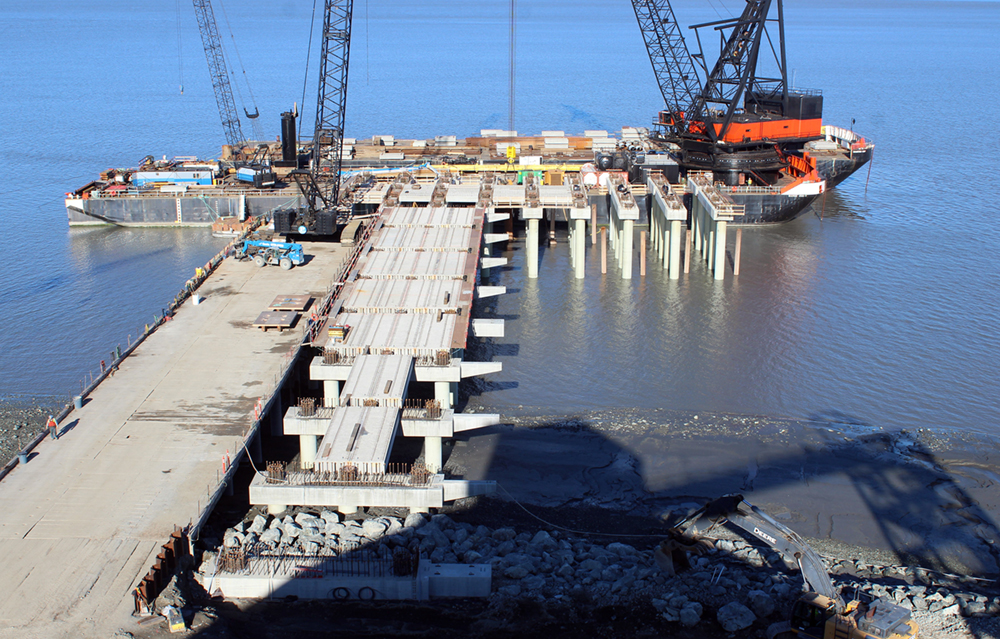
Port of Alaska officials in Anchorage say they expect construction to be complete and initial operations underway by late fall on the new multi-million-dollar Petroleum and Cement Terminal (PCT).
The project, contracted to Seattle firm Pacific Pile and Marine (PPM), is the first phase of the Port of Alaska Modernization Program. The project involves replacement of the Petroleum Oil Lubricants Terminal (POL 1), open since 1965, which is severely corroded and suffered significant structural damage during the magnitude 7.1 earthquake that occurred in the Anchorage area in November, 2018.
Port officials said that once the new POL 1 terminal is completed, they intend to demolish the old POL 1 and also general cargo terminal 1, the two oldest docks at the port. The overall aim, they explained, is to improve the safety and efficiency of port operations, to accommodate modern shipping operations and also to improve the port’s resiliency to earthquakes and other disasters.
Pacific Pile & Marine completed the first phase of its project, valued at $45 million, last year and is currently at work on its $72 million contract for 2021, which involves up to 10 subcontractors, said Andy Romine, the company’s project manager in Anchorage. The contractors include marine mammal observers, electricians, ironworkers, drillers, concrete finishers, truck drivers and more.
Port officials said PCT construction activities are expected to continue through November of this year. Among the work being done is crews building mooring dolphins and fenders, installing utilities and petroleum and cement handling equipment, and moving the south floating dock.
Between April and late July work crews are tasked with driving some 61 piles. About 40 piles will be temporary and extracted between August and October, while 21 permanent piles will range from three feet to 12 feet in diameter. Most of the pile driving will use a vibratory hammer instead of a louder impact hammer, and noise and vibration are expected to be similar or less than last year, port officials said. Pile extraction is generally quieter than pile driving, they explained.
The biggest challenge to the project, Romine said, is the presence of Cook Inlet beluga whales, whose population has been listed since 2008 as endangered under the Endangered Species Act. These beluga whales have been experiencing a decline in numbers for more than two decades.
Under regulations in place last year, all pile driving had to stop if whales were within about two miles of the project. This year, construction halts if whales are within 18 miles of the work area, Romine said.
“There are specific rules on when you can drive piles,” Romine said. “Last year there were multiple times when we had to stop work.”
The port has an acoustic monitoring program and has hired a private firm that does acoustic monitoring, he said, adding that an 11-person team is monitoring the whales under a separate contract from four separate land-based stations.
Still, said Romine, “we are glad to be here for a second year in a row.” The 12-foot in diameter piles that PPM will be driving are some of the largest piles in the U.S., he said.
Each pile has a placement margin of error of less than six inches — about three inches off center in any direction — to fit precast concrete pile caps, port officials said.
Pilings and concrete deck being installed in the Petroleum and Cement Terminal are designed to last for 75 years. The facility overall was designed and is being constructed to survive a 1,000-year seismic event; that is an earthquake of a magnitude that has a 0.1 percent chance of happening in any given year, one that would be greater that the 1964 Good Friday Earthquake, which had a 9.2 magnitude.
The PCT trestle and platform are supported by 72 permanent piles about 180 feet long and weighing in at about 150 tons apiece.
Port officials also noted that the PCT’s 2020 steel pile order itself was so large that it had to be fabricated in two foundries in Washington state, one in Illinois and one in Mississippi.
To help protect sea mammals from underwater pile-driving noise that is emitted into the Knik Arm area, the company uses a method described by port officials as “bubble curtains.”
The bubble curtains are created by positioning a concentric sleeve and perforated ring around piles that are being driven; air is pumped through the perforations to create dense curtains of bubbles that surround the piles and diffuse pile-driving noise. Underwater hydrophones are used to monitor the effectiveness of the bubble curtains.
Meanwhile, port officials said, the port modernization program’s general cargo terminal designs, construction schedules and financing are still being determined.
